Organic Grasshopper Bait: A Sustainable Solution
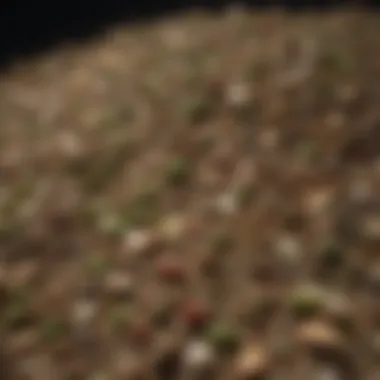
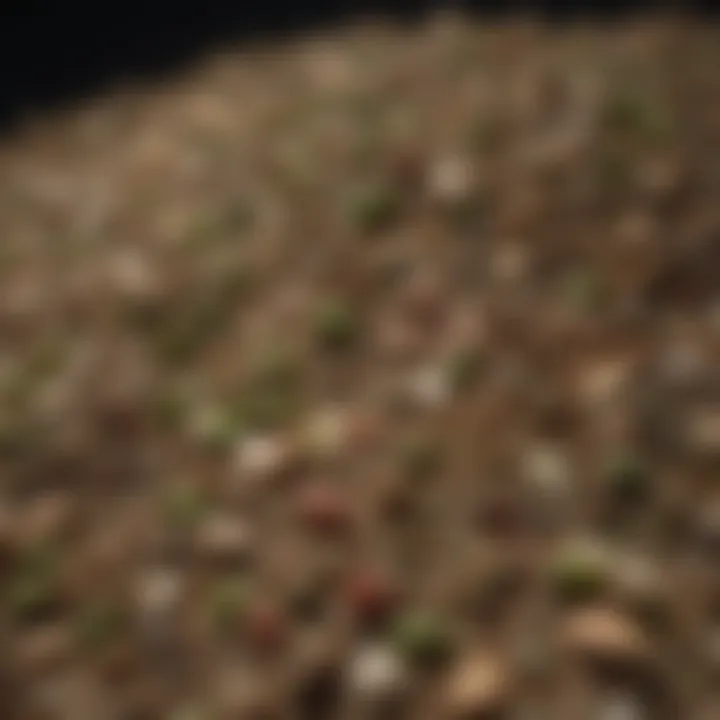
Intro
Grasshoppers represent a formidable challenge in agriculture. Their voracious appetite can devastate crops, prompting many farmers to resort to chemical pesticides. However, the rise of environmental consciousness has catalyzed a shift towards more sustainable methods. Organic grasshopper bait emerges as a compelling alternative. This guide explores this innovative pest control method with a focus on its development, effectiveness, and application. Farmers and environmental enthusiasts alike will find value in understanding how this solution can support sustainable farming practices.
Key Concepts and Terminology
Basic Definitions
Understanding organic grasshopper bait begins with defining key terms.
- Organic Bait: A substance used to attract and kill pests without the use of synthetic chemicals. It often consists of naturally occurring ingredients.
- Grasshoppers: Insects belonging to the order Orthoptera, which can be detrimental to crops through their feeding habits.
- Integrated Pest Management (IPM): A holistic approach to pest control that combines biological, physical, and chemical tools.
Historical Context
The use of natural pest control methods is not new. Historically, farmers relied on a mixture of plant extracts and biological predators to manage pest populations. With the advent of synthetic pesticides in the mid-20th century, these traditional methods were largely abandoned. However, as awareness grows about the ecological impact of pesticides, organic methods are being reevaluated. Today, organic grasshopper bait is at the forefront of this agricultural revolution.
Recent Innovations and Trends
Technological Advancements
Recent innovations in science and agriculture have enhanced the effectiveness and accessibility of organic grasshopper bait. Developments in formulation technologies allow for more effective combinations of attractants and toxic agents derived from natural sources. Additionally, precision agriculture tools enable farmers to target grasshopper populations more efficiently, thereby reducing overall bait usage and minimizing environmental impact.
Sustainable Practices
Adopting organic grasshopper bait aligns with sustainable agriculture practices. It promotes biodiversity by reducing reliance on harmful chemicals. Furthermore, these practices often include rotational grazing and cover cropping to manage grasshopper populations naturally. Farmers are increasingly recognizing that organic solutions contribute to long-term fertility and resilience in their farming systems.
Practical Applications and Techniques
Step-by-step Guides
Using organic grasshopper bait effectively requires a systematic approach:
- Identify Grasshopper Habitats: Look for areas with high grasshopper activity. This can include open fields and gardens.
- Select Appropriate Bait: Choose a formulation suited for your specific environment. Products like Mausu Organic Bait or EcoSMART Grasshopper Control are popular options.
- Application Timing: Apply the bait during peak activity periods, often in warmer months.
- Monitor Effectiveness: Regularly assess the reduction in grasshopper populations to gauge success and make necessary adjustments.
Case Studies
Practical examples can illustrate the efficacy of organic grasshopper bait. For instance, a small farm in Idaho successfully reduced grasshopper infestations by 70% after implementing a targeted organic bait strategy. The farmer noted not only a decrease in crop damage but also a significant improvement in soil health, attributed to the minimized use of harmful chemicals.
To truly understand the impact of organic solutions, one must consider both immediate and long-term benefits to the ecosystem.
Understanding Grasshoppers
Understanding grasshoppers is crucial for anyone involved in pest control, especially in agriculture. They can cause significant damage to crops, so recognizing their traits and behaviors helps in developing effective solutions. An in-depth comprehension of their biological characteristics and life cycles allows farmers and enthusiasts to design targeted and efficient control strategies. This leads to healthier crops and more productive farming practices.
Biological Traits of Grasshoppers
Physical characteristics
Grasshoppers possess distinct physical traits that set them apart from other pests. These insects have long hind legs suited for jumping, which aids in their escape from predators and helps them traverse large areas. The coloration can vary widely, creating patterns that can camouflage them in their surroundings. This characteristic is beneficial for their survival, but also makes them harder to detect when they invade crops, complicating management efforts.
Moreover, grasshoppers feature a hard exoskeleton that helps them withstand various environmental factors. However, this can work against them when targeting them with specific baits effective in the natural environment. Understanding these physical traits supports the development of more precise pest management strategies.
Life cycle overview
The life cycle of grasshoppers is an important element in pest management. Grasshoppers undergo incomplete metamorphosis, consisting of three stages: egg, nymph, and adult. Notably, the nymph stage resembles adults but lacks wings. This characteristic marks a key window for intervention, as nymphs are vulnerable and often more abundant in agricultural settings.
A significant feature of their life cycle is the ability to produce multiple generations within a single growing season. This results in population explosions, leading to extensive damage to crops. Understanding this life cycle allows stakeholders to implement timely intervention measures that can mitigate crop loss.
Behavioral Patterns
Feeding habits
Grasshoppers are primarily herbivorous, which means they consume a variety of plants. Their feeding habits are characterized by chewing leaves, stems, and roots. This plant consumption plays a significant role in their pest status. They can quickly strip crops of their foliage, leading to detrimental effects on yield and health of plants.
A unique feature of these feeding patterns is their adaptation to different plant species. While they prefer tender young shoots, they can sustain themselves on tougher foliage when necessary. Recognizing these feeding habits can aid in developing bait that attracts them and minimizes crop damage effectively.
Migration behavior
Grasshoppers exhibit migratory behaviors, especially when environmental conditions push them to seek out better habitats. This migration can lead to concentrated infestations in new areas, creating challenges for nearby farming practices.
A noteworthy characteristic of their migration is influenced by factors such as weather patterns and availability of food resources. As they migrate, they may swarm large areas, leading to rapid destruction. Understanding this behavior helps devise proactive measures like monitoring and control tactics, especially during peak migration periods.
Ecological Role
Grasshoppers in the food web
Grasshoppers serve as a critical component in the food web. They are key prey for many species, helping to sustain bird populations and other predators. This role makes them an essential factor to consider when developing pest control measures.
Highlighting this ecological role emphasizes the balance needed in managing grasshopper populations. While they can be pests, their presence supports biodiversity, necessitating careful action in pest management strategies.
Impact on soil health
Grasshoppers impact soil health in both positive and negative ways. Their feeding can reduce plant cover, which may lead to soil erosion. However, their waste contributes organic matter back into the soil, which can enhance soil fertility. Understanding this dual role is important for farmers who utilize organic grasshopper bait, allowing them to implement strategies that maintain soil health while controlling pest populations effectively.
Grasshoppers encompass a broad range of influences on agricultural ecosystems. By dissecting their characteristics, behaviors, and ecological roles, stakeholders can establish more effective pest control solutions with organic methods.
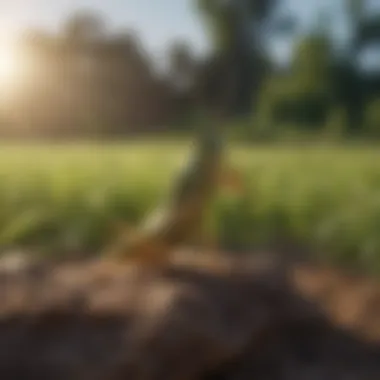

The Need for Organic Solutions
Organic pest control has become increasingly important in modern agriculture. The reliance on synthetic pesticides has raised concerns about health and environmental effects, prompting farmers to explore organic alternatives. This section discusses the challenges posed by synthetic pesticides and the advantages of using organic solutions. Understanding these issues is critical for developing effective pest management strategies that promote sustainable agriculture.
Challenges with Synthetic Pesticides
Health risks
Synthetic pesticides often contain chemicals that can pose serious health risks to humans. Prolonged exposure to these substances can lead to various health issues, such as respiratory problems and hormonal disruptions. Moreover, farmworkers who apply these pesticides are at higher risk of exposure, which can lead to acute poisoning or chronic health conditions.
The key characteristic of these health risks is that they can affect not just those who apply pesticides but also consumers of the agricultural products. Residue from synthetic pesticides may remain on food, posing a risk to public health. Therefore, moving away from synthetic pesticides to organic solutions minimizes these health risks significantly.
One unique feature of focusing on health risks is the growing body of research that underscores the safety of organic farming methods. Organic pesticides usually consist of natural ingredients, often resulting in fewer health hazards. This makes organic practices an attractive choice for health-conscious consumers and farmers alike.
Environmental impact
The environmental consequences of synthetic pesticides are another significant concern. These chemicals can leach into the soil and water, affecting local ecosystems. They can kill non-target species, including beneficial insects, which disrupts the balance of the food web. Over time, this leads to a decline in biodiversity, which is critical for maintaining soil health and agricultural productivity.
The key characteristic here is the long-lasting impact that synthetic pesticides have on the environment. Polluted soils and compromised water sources can lead to a decline in crop yields and an increase in environmental degradation. By contrast, organic alternatives typically have a much lower environmental footprint.
One unique feature of organic pest control methods is that they utilize natural substances that are less likely to harm the environment. This practice supports a healthier ecosystem, benefiting both farmers and the natural world.
Benefits of Organic Alternatives
Sustainability
Sustainability is a core aspect of organic farming, which emphasizes practices that protect the environment, promote biodiversity, and conserve resources. Organic pest control methods help maintain healthy ecosystems by using natural instead of synthetic materials. This contributes to the long-term viability of agriculture and ensures that resources are available for future generations.
The key characteristic of sustainability in organic farming is the focus on systems that work in harmony with natural processes. This method encourages soil health, crop rotation, and plant diversity, all of which are essential for sustainable agriculture.
A unique feature of sustainability in organic practices is that they often reduce dependency on chemical inputs over time. As soil health improves, farmers find that they require fewer external inputs to maintain productive yields. This results in cost savings in the long run.
Safety for non-target species
Organic alternatives are often safer for non-target species, which include beneficial insects, birds, and other wildlife. Harmful effects on these species can lead to imbalances in the ecosystem, such as reduced pollination and increased pest populations. Organic pest control aims to target specific pests while minimizing collateral damage to other species.
The key characteristic here is the use of less toxic materials in organic practices. This targeting reduces risks to humans, animals, and beneficial species, making organic farming a more ecologically responsible choice.
A unique feature of focusing on safety for non-target species is that it results in healthier ecosystems overall. When beneficial species thrive, they can help control pest populations naturally, reducing the need for intervention and steering farmers toward a more sustainable form of agriculture.
By adopting organic solutions, farmers can foster a healthy environment while ensuring economic viability and public safety.
Components of Organic Grasshopper Bait
The components of organic grasshopper bait are fundamental to its effectiveness and overall functionality. As awareness grows regarding sustainable farming practices, understanding these components becomes crucial for farmers and enthusiasts. Focusing on quality ingredients can heighten an organic solution's ability to address grasshopper infestations. Moreover, the right formulations can enhance safety, not just for the user but for other organisms in the ecosystem. It is essential to explore the key ingredients and formulations used in organic grasshopper bait to promote environmentally responsible pest control.
Key Ingredients
Natural attractants
Natural attractants play a significant role in drawing grasshoppers towards the bait. These substances are derived from plant materials or other organic sources. Their primary characteristic is their ability to mimic the scents or flavors that grasshoppers seek. This makes natural attractants a popular choice in organic formulations, as they align with the principles of using harmless, environmentally friendly substances in pest management.
One unique feature of natural attractants is their capacity to engage grasshoppers without introducing synthetic chemicals into the environment. For example, ingredients like molasses can serve as a powerful attractant, enticing grasshoppers with a sweet flavor. However, one disadvantage might be that natural attractants can sometimes require larger quantities to be effective compared to synthetic counterparts. Despite this, their ecological benefits outweigh the shortcomings, as they support sustainable pest control practices.
Repellents
Repellents form an essential aspect of organic grasshopper bait by discouraging the pest from frequenting the areas where they are applied. These can be derived from various natural sources, including essential oils and certain botanical extracts. Their key characteristic is to create an unpleasant environment for grasshoppers, often through strong scents or tastes. This makes them a beneficial choice in organic pest control.
The unique feature of many natural repellents is their dual function. Not only do they deter grasshoppers, but they can also be safe for other beneficial insects. For instance, products derived from neem oil can keep grasshoppers at bay while posing minimal risk to pollinators like bees. However, the effectiveness of natural repellents can sometimes vary based on environmental conditions. Despite these fluctuations, natural repellents are still favored for their ecological friendliness and safety for the broader ecosystem.
Formulations
Dry bait vs wet bait
The decision between dry bait and wet bait is vital in the formulation of organic grasshopper solutions. Both formats bring unique characteristics that cater to different application contexts. Dry bait often has a longer shelf life and can be spread more easily over wide areas, which are critical factors for larger agricultural settings. Moreover, its less messiness can appeal to farmers looking for straightforward applications.
On the other hand, wet bait can sometimes offer more immediate effectiveness due to its moisture content, which can attract grasshoppers more rapidly. The ability of wet formulations to stick to the target can also lead to better results in some circumstances. A disadvantage of wet bait, however, is its shorter shelf life. Recognizing the proper application of each type is key to successful pest management in a sustainable framework.
Homemade vs commercial options
The choice between homemade versus commercial options represents another vital consideration in crafting organic grasshopper bait. Homemade options can offer customization and allow for personal preferences related to specific pest control challenges. It often involves simple processes utilizing easily available materials, thus making it a preferred choice for DIY enthusiasts who are conscientious about sourcing eco-friendly ingredients. However, one must be careful about ensuring that homemade options meet effectiveness standards.
Commercial products bring the advantages of thorough testing and consistent formulations. These products are often designed with specific pest control goals in mind and can offer a level of convenience. Yet, they may not always align with the values of sustainability that many organic advocates prioritize. The right choice will depend on the user's goals, scales, and commitment to environmental responsibility.
Understanding these components provides insight into effective pest control strategies while fostering a commitment to sustainable agriculture practices.
Production of Organic Grasshopper Bait
The production of organic grasshopper bait is vital for several reasons. First, it ensures the efficacy of pest control methods while adhering to environmentally sustainable practices. Second, it focuses on minimizing health risks associated with chemical pesticides. By ensuring high quality and safety, organic bait can serve as an effective solution for managing grasshopper populations without harming other beneficial organisms in the ecosystem. This section will explore the necessary steps, considerations, and practices involved in producing effective organic grasshopper bait.
Selecting Raw Materials
Organic certification
Organic certification is a crucial factor in ensuring that raw materials meet certain standards required for organic products. This certification involves compliance with regulations that prohibit the use of synthetic fertilizers, pesticides, and genetically modified organisms. The key characteristic of certified organic materials is that they must come from approved sources, often requiring traceability back to the farm.
Using organically certified materials is beneficial because it enhances the credibility of the bait. This can appeal to consumers who prioritize sustainability. A unique feature of organic certification is the rigorous inspection process that ensures compliance with organic standards. However, it may also result in higher costs for producers, which can impact pricing.

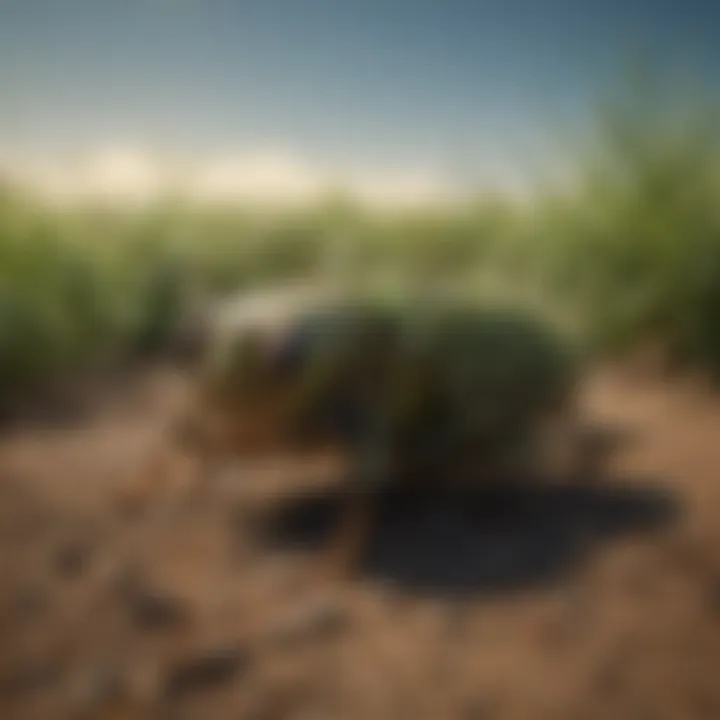
Sourcing practices
Sourcing practices directly influence the quality of the final organic bait product. Sustainable sourcing involves obtaining materials from localized, organic farms whenever possible to reduce transportation emissions and support local economies. A key characteristic of effective sourcing practices is transparency. This can foster trust among producers and consumers alike.
Sourcing from reliable local suppliers is a beneficial choice because it often guarantees fresher ingredients. A unique feature of sustainable sourcing is the potential for building long-term partnerships with farms, which can lead to improved practices over time. Nevertheless, relying on local options may limit ingredient availability, prompting producers to explore alternatives or enhance relationships with multiple suppliers.
Manufacturing Process
Mixing techniques
Mixing techniques are essential to ensure an even distribution of ingredients in organic grasshopper bait. Effective mixing is vital for enhancing the product's efficacy and ensuring that each application delivers consistent results. The primary characteristic of mixing techniques in organic bait is that they must preserve the integrity of all organic materials, preventing any degradation of active components.
Using advanced mixing technologies can improve the overall quality and reduce production time. A unique feature of skilled mixing is the ability to create various textures, whether dry or wet, depending on the desired application. However, improper mixing can lead to uneven distributions, impacting bait effectiveness and making quality control even more critical.
Quality control measures
Quality control measures play a vital role in maintaining the integrity and effectiveness of organic grasshopper bait throughout production. These measures involve multiple stages of verification, including ingredient inspections, in-process monitoring, and final product testing. A key characteristic of quality control is its focus on consistency and compliance with organic standards.
Implementing rigorous quality control measures ensures that the bait meets safety and efficacy benchmarks, which is beneficial for producers and consumers. A unique feature of these measures is the establishment of standard operating procedures that guide actions during production. However, comprehensive quality control processes can increase production time and cost, making them a challenge for some manufacturers.
Application Techniques
The section on application techniques is crucial. Understanding how to effectively apply organic grasshopper bait enhances its performance in controlling these pests. The right techniques ensure that the bait attracts grasshoppers without causing harm to non-target species. This leads to more efficient pest management practices. Here, we explore the timing and frequency of applications, as well as the methods of application.
Timing and Frequency
Optimal application periods
Optimal application periods refer to the best times for applying organic grasshopper bait. The specific aspect of this is understanding the grasshopper lifecycle. Grasshoppers are more active during certain seasons, particularly in late spring and early summer. Applying bait during these active periods significantly increases the chances of effective pest control. This characteristic makes it a popular choice as it aligns with when grasshoppers are most likely to encounter the bait.
One unique feature of optimal application periods is the consideration of weather conditions. Rain can wash away bait, diminishing its effectiveness. Therefore, applying the bait before dry, calm weather is ideal. However, there can be disadvantages; for instance, if conditions are too dry or too wet, it may deter grasshoppers entirely, making the bait less effective.
Reapplication guidelines
Reapplication guidelines are vital for maintaining control over grasshopper populations. This aspect focuses on how often the bait should be reapplied. Typically, reapplication is necessary every two to four weeks, depending on environmental factors and local pest pressures. This frequency ensures that grasshoppers continuously encounter fresh bait, increasing the likelihood of successful pest management.
A key characteristic of these guidelines is their adaptability to changing conditions. If heavy rainfall occurs, reapplication may need to happen more frequently to ensure ongoing control. The unique feature of reapplication guidelines is the flexibility they offer, allowing adjustments based on observed effectiveness. However, the downside could be the additional labor and cost involved in frequent applications.
Method of Application
Direct application techniques
Direct application techniques involve spreading the organic grasshopper bait directly onto affected areas. This method ensures that the bait is exactly where it needs to be, making it a straightforward approach. One of its key characteristics is its simplicity; it requires minimal setup and can be done with basic equipment. This is a beneficial choice for farmers or enthusiasts looking for efficient solutions.
A unique aspect of direct application is the ability to see immediate results. After application, one can monitor for grasshoppers directly interacting with the bait. However, a disadvantage is that improper application might lead to bait being placed in less effective locations, risking reduced efficacy.
Use of traps and containers
The use of traps and containers adds another layer to grasshopper management. This technique offers a controlled way to capture grasshoppers without scattering bait in the environment. It can be particularly effective in localized infestations. The key characteristic here is the targeted approach; traps can be placed strategically in high-activity areas, ensuring better capture rates. This method is beneficial for areas where bait dispersion may lead to waste or contamination of non-target species.
One unique feature with traps is the ease of monitoring captured pests. The number of grasshoppers caught can provide valuable data for further pest control measures. However, this method has drawbacks, such as the need for regular checking and maintenance of the traps to ensure they remain effective.
Effective application of organic bait increases its effectiveness, ensuring better control of grasshopper populations while being mindful of the environment.
Efficacy and Monitoring
Efficacy and monitoring are crucial components of implementing organic grasshopper bait effectively. This section delves into the importance of tracking how well the bait works and making necessary adjustments. The overall success of pest control efforts directly relates to how accurately we assess and monitor the impact of the bait used. Thus, understanding methods for measuring effectiveness and adapting strategies over time is paramount.
Assessing Bait Effectiveness
Observation techniques
Observation techniques form a core part of assessing bait effectiveness. These methods allow farmers to track the behavior and population dynamics of grasshoppers in relation to the bait's use. Regular observation offers insights into which areas show the most activity and whether the bait attracts or deters grasshoppers effectively. One key characteristic of observation techniques is that they are non-invasive. Observations can be made without disturbing the pests, thus providing more reliable data on their behavior.
However, these techniques can be time-consuming. Farmers need to dedicate time to perform thorough checks in various locations. Observations may also require a keen eye for detail, especially in distinguishing the effects of bait from natural population fluctuations. Despite these challenges, the benefits of consistent observation can significantly inform future pest management efforts.
Use of controls
The use of controls is another critical aspect of assessing bait effectiveness. Controls typically involve comparing treated areas with untreated ones, providing a baseline for understanding the impact of the organic bait. This method highlights the unique characteristic of having a clear reference point, thus making it easier to evaluate how successful the bait is over time. It's a beneficial choice for this article since it provides a structured approach to monitoring efficacy.
However, the downside may include the need for more resources, as setting up control areas can take additional planning and effort. Controls must also be replicated adequately to ensure the data is robust and reliable. Nevertheless, when used effectively, they can deliver powerful insights into the true performance of organic grasshopper bait.
Adapting Strategies
Feedback mechanisms
Feedback mechanisms play an essential role in adapting strategies related to organic grasshopper control. These mechanisms allow for continuous improvement based on observed outcomes. Farmers can use feedback collected through various observation channels to refine their approach. A key characteristic of feedback mechanisms is their adaptability. They encourage adjustments to be made based on real-time data rather than assumptions. This makes them a popular choice within organic pest control discussions.
The unique feature of feedback mechanisms lies in their dynamic nature. By being responsive to changing conditions in the field, they enhance the overall effectiveness of pest control efforts. However, they require diligence and commitment from farmers, which can be a disadvantage for those with limited time. Overall, the ability to adapt strategies based on feedback can significantly optimize the management of grasshopper populations.
Improving formulations
Improving formulations is essential to enhance the overall efficacy of organic grasshopper bait. This area focuses on refining bait mixtures to increase their attractiveness and effectiveness. The key characteristic of improving formulations is its emphasis on innovation in pest control tactics, making it a beneficial component of this guide.
Unique features of improving formulations include experimenting with different ratios of natural attractants and repellents tailored to specific environments. This can lead to more efficient use of resources as well as better outcomes for pest control. However, the downside may involve trial and error, which can require time and testing. Overall, ongoing improvements can ensure that the bait remains effective against evolving grasshopper behaviors, thus supporting sustainable agriculture practices.
Case Studies and Success Stories
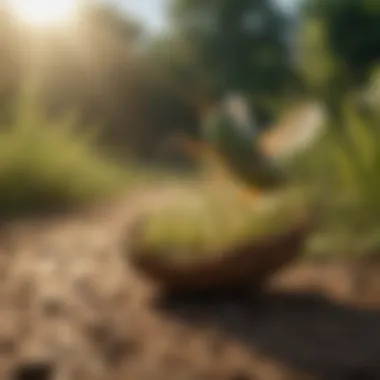

Case studies and success stories are crucial in illustrating the practical application of organic grasshopper bait. They provide evidence of the efficacy of these solutions in real-world scenarios. By examining specific examples, farmers can better understand the results that can be achieved. These narratives can offer insights into both successes and challenges encountered when adopting organic practices.
Examples from Farmers
Comparative results
Comparative results from different farms reveal the effectiveness of organic grasshopper bait compared to traditional methods. Farmers have documented improvements in grasshopper management, often highlighted by reduced pest numbers and less crop damage. This comparison offers a clearer picture of the benefits of going organic. One key characteristic is the observable decrease in grasshopper populations, which demonstrates how organic bait can disrupt their life cycles. This method proves to be beneficial because it encourages sustainable farming practices.
Additionally, the unique feature of these comparative results lies in the versatility of the organic formulations employed. Farmers can customize their approaches based on the specific conditions and types of crops they manage. However, one disadvantage is that results may vary depending on environmental factors and pest resistance. Yet, the overall positive feedback reinforces organic methods in pest control.
Long-term benefits
Long-term benefits are another notable aspect observed in the use of organic grasshopper bait. Many farmers report improved soil health and increased biodiversity as a result of their pest management choices. This characteristic is particularly beneficial because it transcends immediate pest control, contributing to the ecosystem's resilience over time. Farmers who have embraced this approach often see a sustained decrease in pest populations over successive growing seasons.
A unique feature of these long-term benefits is the positive feedback loop created; healthier soil promotes strong plant growth, which in turn can better withstand pest pressure. While there are some initial investment costs and a learning curve associated with organic methods, the long-term gains often outweigh these short-term challenges. This is especially true for farmers committed to sustainability.
Research Findings
Research findings from academic institutions provide an additional layer of credibility. Studies lend a scientific perspective on the efficacy of organic grasshopper bait, supporting anecdotal evidence from farmers.
University studies
University studies often focus on the effectiveness of various organic compounds in deterring grasshoppers. These studies highlight how specific ingredients can lower grasshopper populations. They are valuable because they add a level of scientific rigor to the conversation around organic solutions. Furthermore, the unique aspect of university-backed research lies in the controlled environments where these studies are conducted, providing comprehensive data on the performance of organic bait.
However, one downside is that research outcomes may not always reflect field conditions. Nonetheless, these studies serve to validate many of the practices farmers are implementing and provide a strong argument for adopting organic methods.
Field trials
Field trials conducted in diverse agricultural settings showcase the practical application of research findings. These trials often reveal the best practices for applying organic grasshopper bait under varied conditions. A standout quality of field trials is that they are conducted in real-world scenarios, allowing researchers to assess the performance and adaptability of products in environments similar to where they will be used.
While field trials provide significant insights, they also present some limitations. The variability of conditions can lead to inconsistent results. Despite this concern, the overall consensus from these trials tends to support the effectiveness and viability of organic options.
Future Directions in Organic Pest Control
The landscape of pest management is evolving due to increased awareness of environmental sustainability. Future directions in organic pest control focus on leveraging innovative techniques that align with ecological principles. Emphasizing the adoption of organic methods can improve agricultural resilience. The upcoming trends and research opportunities shape this progressive path.
Emerging Trends
Biotechnology advancements
Biotechnology advancements represent a promising facet of organic pest control. These methods enhance pest management through genetic insights and bioengineering techniques. Some products now offer a refined approach to targeting specific pests while minimizing impacts on beneficial organisms. This specificity is a key characteristic that makes biotechnology a preferred choice.
Biotech solutions often utilize natural organisms modified to disrupt pest life cycles. This can lead to reduced pesticide applications, which is beneficial in protecting both crops and the environment. However, concerns about genetic modification are also part of the ongoing discussions. Issues can rise regarding the potential consequences on ecosystems and human health. Therefore, while biotechnology solutions boast substantial advantages, careful evaluation remains essential.
Integrated pest management
Integrated pest management (IPM) is another focal point in the future of organic pest control. This method combines biological, cultural, and chemical practices to effectively manage pest populations. Its interdisciplinary nature enables a comprehensive approach to agriculture, allowing farmers to reduce pest abundance with less pesticide reliance.
One of the hallmark features of IPM is its flexibility to adapt to different agricultural systems. This adaptability makes it a popular and effective strategy for farmers seeking sustainable practices.
The integration of monitoring and assessment within IPM provides long-term benefits. It allows farmers to respond to changing pest dynamics promptly. However, implementing IPM can be challenging, especially for farmers new to such practices. Training and awareness are necessary to ensure effective uptake.
Research Opportunities
Long-term sustainability studies
Long-term sustainability studies play a vital role in assessing the effectiveness of organic practices over various time scales. These studies can contribute crucial data about soil health, biodiversity, and pest population stabilization. Their significance lies in generating knowledge that can guide future practices.
The unique feature of these studies is their ability to provide insight into the long-term impacts of organic methods. Research substantiates claims about the resilience afforded by these practices. Despite the vast benefits, the resource-intensive nature of long-term studies can limit their execution.
Gaps in current knowledge
Addressing gaps in current knowledge remains imperative for advancing organic pest control methods. Identifying what is not yet understood about pest biology, behaviors, and interactions with various environments is essential. Highlighting these gaps aids in directing future research efforts efficiently.
The benefits of filling these knowledge gaps extend beyond theoretical understanding. They can lead to better formulations of organic pesticides and improved management strategies. Increasing awareness about these gaps fosters collaboration among researchers, farmers, and policymakers. However, such collaborative efforts can demand significant coordination and funding, which can be a challenge.
"Future directions in organic pest control require innovation, collaboration, and commitment to sustainable practices to secure agricultural health."
Ending
The conclusion of this article emphasizes the significance of organic grasshopper bait in modern agricultural practices. This guide has outlined multiple aspects of organic pest control, focusing on the benefits, application techniques, and potential for future advancements. The importance of maintaining sustainable farming practices is becoming increasingly recognized. The use of organic solutions not only aligns with this goal but also promotes environmental health and safety.
Summary of Findings
Impact on agriculture
The impact of organic grasshopper bait on agriculture cannot be overstated. This method provides a practical solution for farmers aiming to manage grasshopper populations while minimizing harmful effects on ecosystems. Organic bait encourages biodiversity by targeting specific pests and preserving beneficial organisms. Organic grasshopper control also reflects a growing trend towards more responsible farming.
Benefits of organic methods
The benefits of using organic methods are numerous. Primarily, these approaches reduce chemical residues in crops. This is crucial for consumer safety and for meeting market demands for organic produce. Organic methods can also lead to improved soil health. This is because they often involve natural fertilizers and reduced chemical runoff. Such practices support not just sustainable agriculture but also longer-term agricultural productivity.
Call to Action for Adoption
Encouraging sustainable practices
Encouraging sustainable practices is vital for the future of agriculture. Farmers need to adopt eco-friendly techniques that fulfill pest management duties without harming the environment. Organic methods can lead to healthier ecosystems. Moreover, they can help farmers adapt to changing regulations and market demands.
Community involvement
Community involvement plays a key role in advancing organic pest control. When local farmers collaborate, they share knowledge and resources effectively. This leads to more innovation and progress in sustainable practices. Additionally, community engagement fosters a sense of shared responsibility towards environmental stewardship. By working together, rural communities can create lasting change in agricultural practices.
Overall, the transition towards organic grasshopper bait reflects a larger shift in agriculture that values ecological balance.















